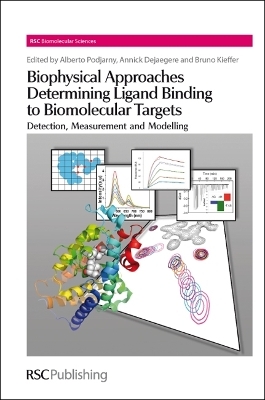
Biophysical Approaches Determining Ligand Binding to Biomolecular Targets
Royal Society of Chemistry (Verlag)
978-1-84973-009-9 (ISBN)
The binding of small ligands to biological molecules is central to most aspects of biological function. The past twenty years has seen the development of an increasing armoury of biophysical methods that not only detect such binding, but also provide varying degrees of information about the kinetics, thermodynamics and structural aspects of the process. These methods have received increasing attention with the growth in more rational approaches to drug discovery and design. This book reviews the latest advances in the application of biophysics to the study of ligand binding. It provides a complete overview of current techniques to identify ligands, characterise their binding sites and understand their binding mechanisms. Particular emphasis is given to the combined use of different techniques and their relative strengths and weaknesses. Consistency in the way each technique is described makes it easy for readers to select the most suitable protocol for their research. The introduction explains why some techniques are more suitable than others and emphasizes the possible synergies between them. The following chapters, all written by a specialist in the particular technique, focus on each method individually. The book finishes by describing how several complimentary techniques can be used together for maximum effectiveness. This book is suitable for biomolecular scientists at graduate or post-doctoral level in academia and industry. Biologists and chemists will also find it a useful introduction to the techniques available.
Alberto Podjarny is Research Director at the CNRS, Strasbourg and Group Leader of Crystallographic Methodology and Enzyme Catalysis and Inhibition at the IGBMC, Illkirch. Prior to that, he was a Professor at the University of La Plata, Argentina and a Visiting Associate Professor at the University of Chicago. His PhD was on structural chemistry at the Weizmann Institute of Science and he carried out post-doctoral studies in protein crystallography at the University of Chicago Sigler Labaroratory. Annick Dejaegere obtained his PhD in Physical Chemistry from the Free University of Brussels before carrying out post-doctoral studies in biophysics at the Harvard University Karplus Laboratory. He was an Associate Professor at the University of Strasbourg prior to becoming Group Leader in Biocomputing at the IGBMC. Bruno Kieffer completed his PhD in biochemistry at the University of Strasbourg before undertaking post-doctoral research in biomolecular NMR at the Campbell Laboratory of the University of Oxford. He was Professor of biophysics at the European School of Biotechnology in Strasbourg before becoming leader of the biomolecular NMR group at the IGBMC.
Introduction: The who, where, why questions;
NMT;
X-ray;
Surface plasmon resonance Flourescence;
Electropspray ionization mass spectrometry;
Synchrotron circular dicroism;
Thermal denaturation in presence of a fluorescent dye;
Calorimetry;
Molecular modelling Examples of the simultaneous use of several techniques to determine ligand binding
| Erscheint lt. Verlag | 1.4.2011 |
|---|---|
| Reihe/Serie | RSC Biomolecular Sciences ; Volume 22 |
| Verlagsort | Cambridge |
| Sprache | englisch |
| Maße | 156 x 234 mm |
| Gewicht | 685 g |
| Themenwelt | Naturwissenschaften ► Biologie ► Biochemie |
| Naturwissenschaften ► Chemie | |
| Naturwissenschaften ► Physik / Astronomie ► Angewandte Physik | |
| ISBN-10 | 1-84973-009-1 / 1849730091 |
| ISBN-13 | 978-1-84973-009-9 / 9781849730099 |
| Zustand | Neuware |
| Informationen gemäß Produktsicherheitsverordnung (GPSR) | |
| Haben Sie eine Frage zum Produkt? |
aus dem Bereich


